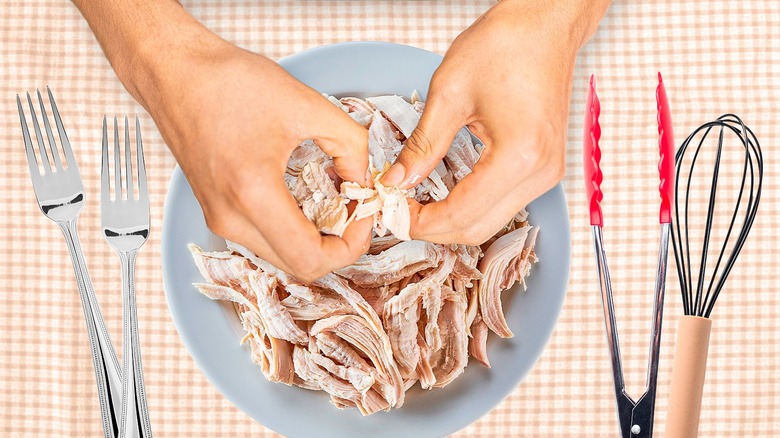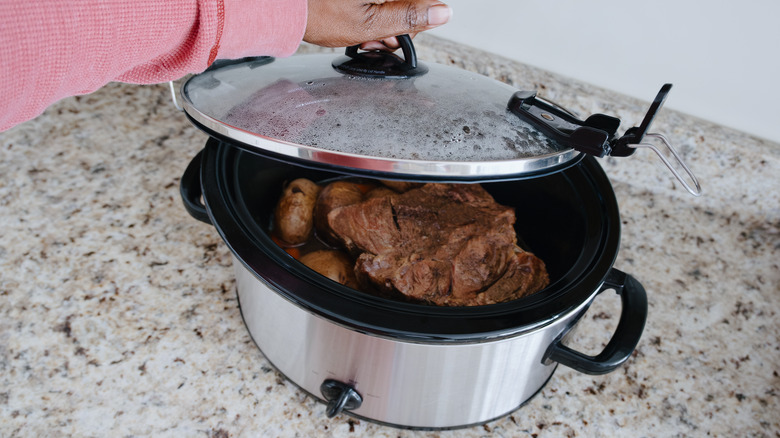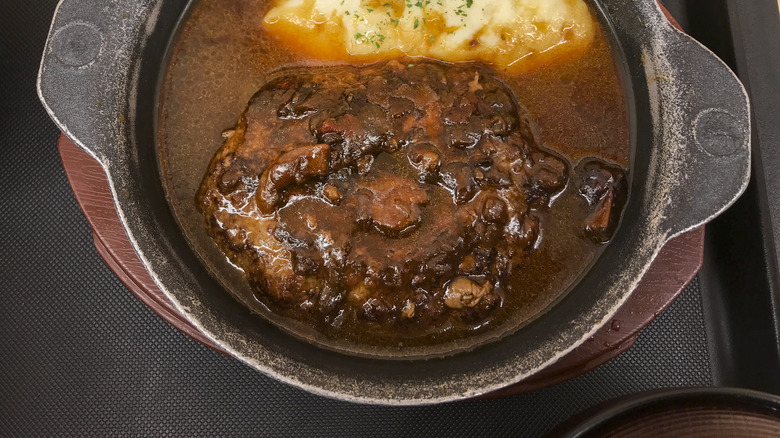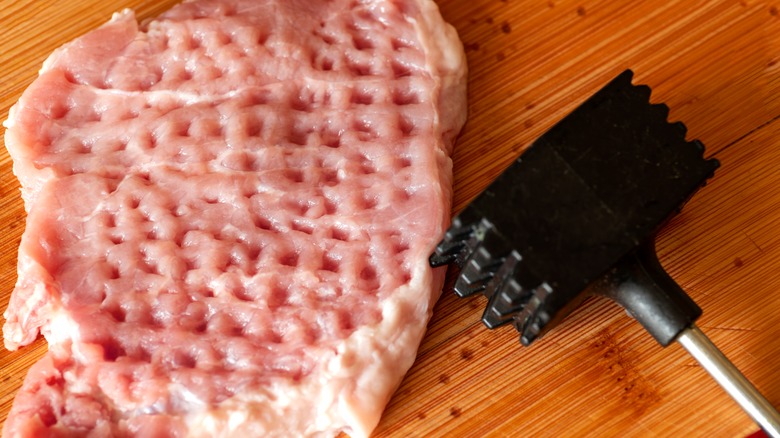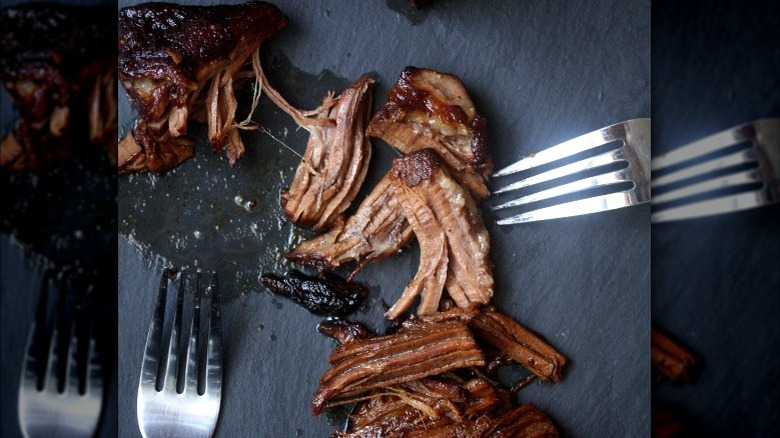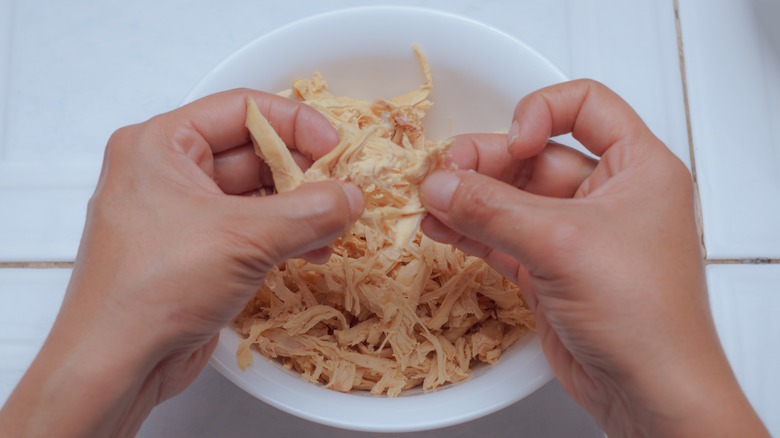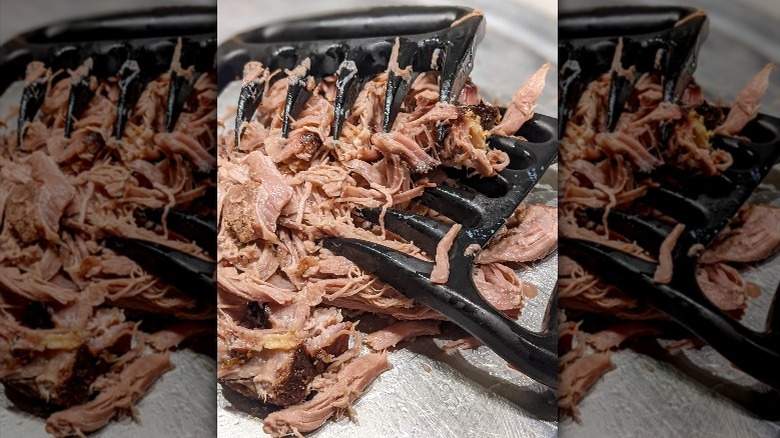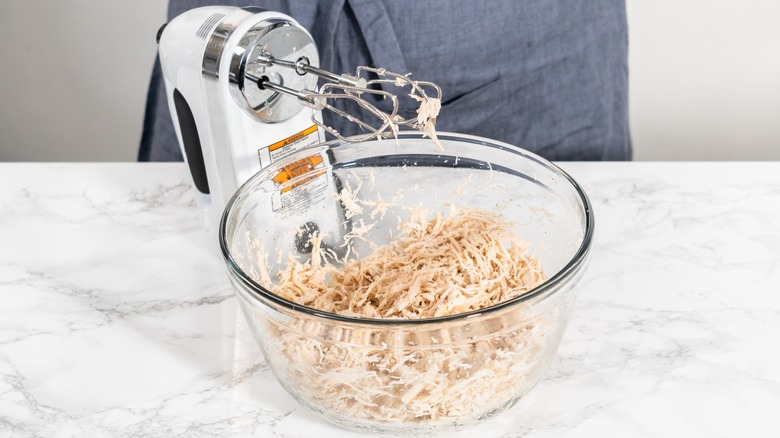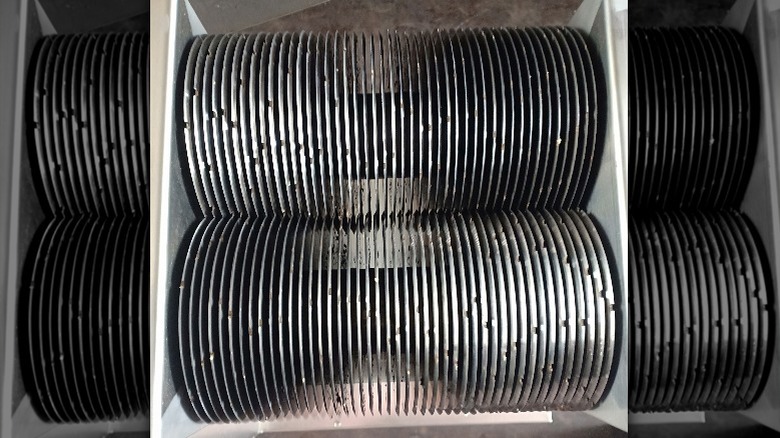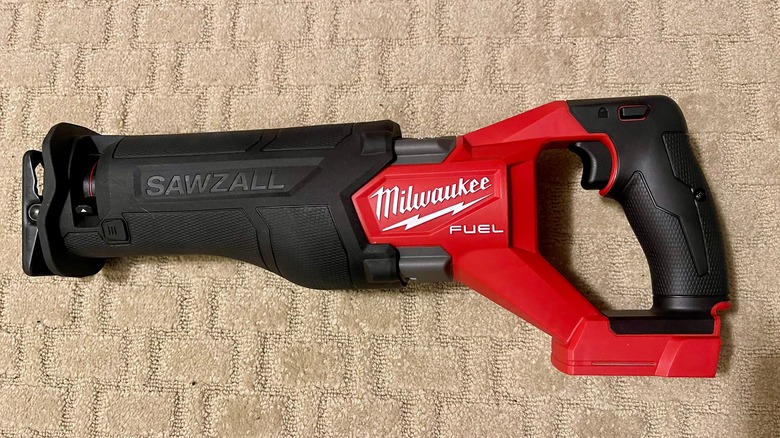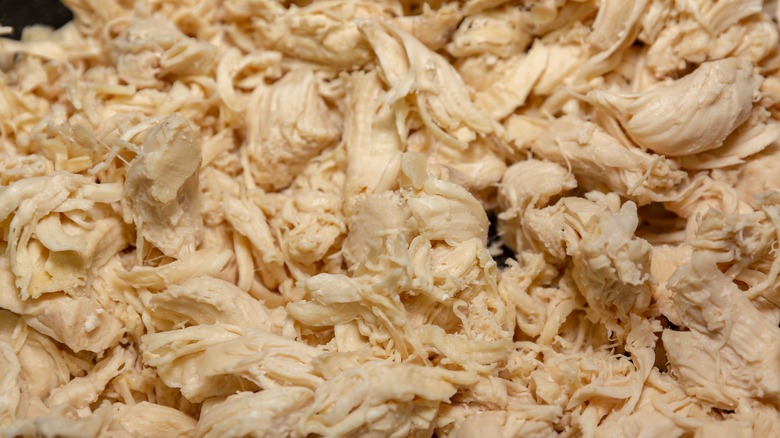11 Expert Tips That Make Shredding Meat A Breeze
Do you groan in frustration when you see shredded meat listed in a recipe or hesitate to make certain dishes because shredding meat is a hassle? Shredded meat isn't just for certain cultural dishes or to make a meal easier to eat, shredded meat is a versatile form of protein that can be added to a number of recipes. Because there's a larger area of the meat exposed, it can absorb extra flavor from sauces and seasonings, packing more taste into one bite.
But shredding meat doesn't have to be difficult, even if you're cooking for a large number of people. From tearing into the meat using your hands to investing in a nifty gadget that does all the work for you, you can shred chicken, beef, pork, and lamb with ease to create tacos, salads, soups, and much more. For the last 10-15 years, I've shredded hundreds of pounds of meat for my (large and hungry) dogs, along with years of recipe testing experience. I've tried every tip listed except using a specialized shredding machine. My favorite method is cooking meat low and slow, so it naturally falls apart and then bastes in its own juices. It takes moments to shred with forks. But I've also heavily relied on a food processor to do the job as well.
1. Slow cook your meat
Slow cooking is one of my favorite ways to create tender, fall-apart pieces of protein but this method of cooking has multiple benefits that go beyond the result of shredding meat easier. It allows you to cook a large volume of meat at one time. Plus, you can take advantage of tougher cuts that also happen to be more affordable, which shouldn't be overlooked. The various methods of slow cooking use dry heat at a low temperature, which melts the collagen slowly. This action turns the connective tissue into a soft gelatinous texture that results in meat so tender it falls apart on its own, making it easy to shred with very little labor.
Another great thing about shredding meat that's been cooked low and slow is that it opens up a variety of flavor profiles for you to match your shreds with a recipe. For instance, to make a Mexican dish with shredded beef, place a chuck roast (one of the best cuts of beef to slow cook) in your slow cooker with spicy seasonings, such as chili pepper, garlic, onion, and cumin, which infuses the meat and adds multiple layers of flavor.
I've had great luck slow cooking lamb shoulder, pork shoulder, whole poultry, and multiple cuts of beef in a slow cooker, oven, and smoker. The meat can also be shredded with ease using just a couple of forks or tongs. The few times I came across meat that was tougher than normal, I put chunks into the food processor for a quick pulse.
2. Cook your meat in liquid
Similar to slow cooking, cooking meat in liquid works to denature muscle fibers so the connective tissue liquifies, resulting in tender meat. The slight difference is that cooking meat in liquid — be it simmering, braising, boiling, or poaching, uses both dry and moist heat. You get the added bonus of your meat holding onto more moisture and flavor, so your shreds don't become dry and dull. You can also shred the meat in the liquid so it absorbs more liquid while simultaneously contributing collagen and seasoning to the pot, creating a delicious broth.
I've cooked beef, lamb, pork, poultry, and bison in liquid. Braising and poaching are more effective at softening meat for shredding than simmering and boiling. Bone-in and skin on fare better than boneless or skinless cuts. Though simmering involves cooking over low heat so your meat cooks slowly, you run the risk of actually overcooking the meat to the point it becomes tough. The same risk happens with boiling. However, I have found that adding fresh lemon juice to the liquid combats this, which is fine if you want your meat to have a slight lemon flavor or acidic undertones.
3. Tenderize tougher cuts of meat
Slow cooking naturally tenderizes meat, making it a straightforward way to create shreds. But what if you didn't plan ahead for an appropriate, yet lengthy, amount of cooking time? There are other ways to tenderize meat so you can shred it without much hassle. This is especially helpful if you've sourced tougher cuts of meat. Similar to meat for mincing, tougher cuts require breaking down the connective tissues to help make the meat more pliable. This will lead to better shreds (and better mince.)
Various prepping techniques exist for tenderizing meat in order to loosen up the plethora of muscle fibers running throughout the cut. You're probably familiar with a mallet — a kitchen utensil that features little teeth made for lightly puncturing raw meat when you hit it. This action gently breaks down the tissue, so your meat is much more tender when you cook it. Methods such as marinating, dry brining (my chosen method for tougher cuts), and fruit use acid, salt, and enzymes, respectively, to dissolve and soften the muscle to bring out its natural deep taste while contributing additional seasonings. Baking soda, which is one of the most versatile items you can have in your home, also tenderizes meat using a chemical reaction to halt muscles from tightening.
4. Shred meat while it's still warm
I have found the best time to shred meat is while it's still warm. Of course, you want to make sure you continue to follow the rule of resting meat for roughly 10 minutes when it's done cooking, but wait until your cut of meat has cooled enough to touch, regardless of the shredding approach you choose to use. Shredding meat that's too hot could burn your fingers if you're using your hands (ask me how I know). It could also stick together as one big clump if you're using a processor or mixer. This turns into an unwanted (and annoying) task of declumping the meat and trying to scrape it off the mixer blades or out of the processor container.
When the meat is just warm, it readily pulls away from the bone, allowing you to separate the parts you want from the parts you don't. You'll also have a better time distinguishing the difference between muscle meat and tendons or cartilage. Warm meat shreds easier thanks to the loosened muscle fibers that separate from each other without issue. Colder meat is difficult to shred because the muscle becomes tighter, and the fat solidifies, making it a little tough to pull apart. You end up with larger pieces rather than typical long shreds from warm meat. If you are using cold leftovers out of the fridge, gently warm up the meat, preferably in liquid, so it becomes more flexible.
5. Use your hands to have more control over the size of your shred
What better shredding tool is there to use than the ones you were gifted? Your hands are some of the best kitchen accessories when it comes to creating your culinary masterpieces. And who doesn't like to play with their food? Another reason why your best option for shredding meat when it's warm and not too hot is to keep your hands safe. If you're uncertain about handling meat with your bare hands, though, consider putting on some food service gloves to get the job done.
A major benefit to shredding meat with your hands is the control you have regarding the size of the shreds and overall end result. You can be as picky as you like or make various shred sizes and thicknesses, giving it a more homemade look. Uneven shreds are great for soups, salads, and subs. But they're also great for adding in omelets, rice bowls, and simple throw-together leftover recipes. There's no hard-and-fast rule, in my experience, regarding shredding by hand. After I've slow-cooked meat and let it cool, I dig in and tear off shreds. The meat naturally breaks apart at the grain.
6. Use assorted kitchen utensils
There are a number of items probably already in your kitchen that can be used to shred meat. From more obvious utensils to accessories used for other purposes, nearly anything with teeth or blades is a viable option to cut your meat into thin (or thick) threads. One of the most common ways to shred meat is with two large forks. This strategy is simple, and while you can use the everyday forks you eat with, it's best done with larger serving forks. When your meat is done cooking and resting, gently pull the meat in different directions using the fork's tines.
Other kitchen utensils are just as handy. Meat claws feature multiple, long, sharp teeth that are designed to effortlessly strip meat. Unlike serving forks that usually have long handles, meat claws have convenient grip handles. But even if you don't have meat claws on hand, you just might have a spaghetti server in your drawer. Shaped like a clawed spoon, a spaghetti server has claw teeth that are able to gently pull meat.
Consider your cheese grater for more than just cheese. Cut your meat into chunks. Choose from small to large holes to customize your shred size. Instead of cutting butter into flour, you can use a pastry cutter to finely shred meat, though I've found it's a better instrument for flaking fish. Tongs and whisks can work in a pinch but may require a little bit more effort.
7. Shred meat with a food processor or mixer
A simple trick to shred meat with ease involves kitchen appliances that may be taking up space on your counter or are nestled away in your cabinets. A food processor, stand mixer, or hand mixer is a convenient way to quickly break up cooked meat. This method requires cutting your meat into chunks, so they fit into a bowl or the processor's container. Though these options will have your meat shredded in a matter of moments, you don't have as much control over the end result of your shred.
Connect the dough attachment to your food processor and use the pulse option to gently break up chunks of meat in bits and spurts. The dough attachment helps prevent your meat from becoming pureed while the pulsating action allows you to check on your process as you go. If you've got a stand mixer, use the paddle attachment. A hand mixer can work as well; keep it on the low setting and take your time so you don't overdo it and create a meaty paste instead.
I've relied on a food processor for shredding all types of meat. It works great on tougher cuts, but shreds end up fairly short and you might wind up with some chunks mixed in. But it's quick, efficient, and requires very little effort.
8. Invest in specialized shredding gadgets
Manual and electric meat shredders are designed specifically for shredding meat. If you have room in your kitchen, like to have multiple kitchen appliances or do a lot of shredding, consider these specialized gadgets to create your next BBQ pulled brisket or pork. They come in a variety of types, but the concept for each is similar — rotating blades or teeth shred the meat, either by a hand crank or electrical power cord. Sizes range from something you can store in your cabinets to commercial meat shredding machines you're more likely to see in a restaurant or BBQ joint.
If you don't shred meat on a regular basis, consider a simple hand crank tool. Place meat in a shallow bowl, put the cover on — both of which are outfitted with teeth, and turn the top so the teeth slice through the meat, creating shreds. If shredding meat is on your weekly to-do list, you might want to think about getting an electrical meat shredder that handles the entire shredding process. Simply place the meat in the machine and turn it on. Voila. Shredded meat.
9. Think outside your kitchen and grab a power tool
Ok, so maybe there isn't much need to use a power tool when it comes to shredding meat. But it's quick, efficient, and makes shredding meat a breeze. After all, it's a power tool. I first discovered this when an unexpected camping trip left me with only the tools in our car. It began as a joke but turned out to be useful. It works similar to an electric knife. I placed the meat in a large stainless bowl and cut the meat in various directions to obtain rough shreds.
The Sawzall uses blades with jagged teeth, making it a better contender for carving your turkey or cutting through bone. The blades are solid, made from stainless steel, and hold an edge for a long time. While not my first choice for shredding, it works in a pinch. Just be sure the blades of your Sawzall are super clean for cutting up your meat. Better yet, reserve the power tool for culinary uses and keep a separate one for your handyman needs.
A multi-tool with an oscillating blade attachment is designed for custom woodworking and slices back and forth at a high rate of speed. These blades are durable and strong and can tackle your toughest cuts. Sure, there are better options but if you're looking for a fine shred, an oscillating blade could be the tool you need. Although I have never personally tested this one myself.
10. Buy your meat pre-shredded
The easiest way to shred meat is to buy it already shredded. Of course, it won't be as fresh as cooking your own meat and then shredding it yourself. But if you're pressed for time or want something quick to grab, it doesn't get much easier than opening a bag or container of shredded meat. Since you don't have as much control over the quality, though, pre-shredded meat may vary in size and thickness. It also may be drier than you'd like and would go best in dishes that feature sauces, broth, or dressing.
Your options may also be limited depending on where you source pre-shredded meat from. But you should be able to find chicken, pork, and beef in your grocer's deli section. You may find it already bagged or freshly shredded in the store's deli containers. And just like you can ask a barista to grind whole beans you've just purchased, you may be able to ask the butcher to shred cooked meat you just bought.
11. Consider using canned meat
A handy option, canned meat should probably be in everyone's pantry. It's convenient, shelf-stable, and ready to use whenever you need it. Canned meat can never take the place of fresh meat, but it can be added to numerous recipes, such as topping salads, mixed in casseroles, or as a fast way to make tacos. Though you won't be serving canned roasted chicken or canned roast beef as the centerpiece at your dining table, you can create tasty dishes that are worthy of all the attention an entire bird or large cut of meat gets.
Canned meat is typically available as chicken, pork, or beef and may come in chunks or shreds. Usually packed in water, the chunks break apart with a fork if you want to enjoy them as shreds instead. Some canned meat comes in gravy or sauce, too, making it even more convenient to craft quick weeknight meals.
